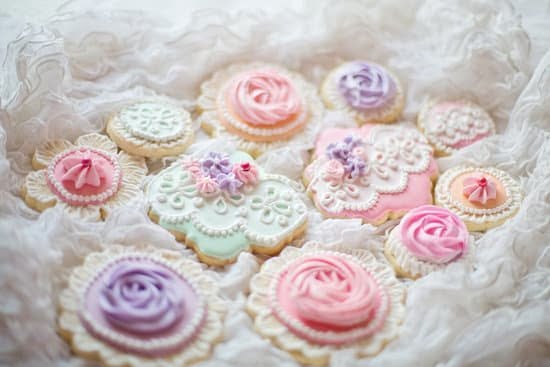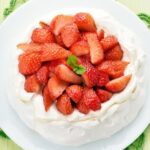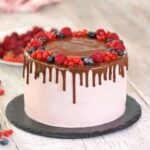When it comes to cake decorating, there are a plethora of techniques and materials to choose from. Two popular options that can create stunning and intricate designs are fondant and buttercream. However, many bakers find themselves wondering if these two can be combined – can you put fondant decorations on a buttercream cake? In this article, we will delve into the world of cake decorating and explore the compatibility of fondant and buttercream.
Before we dive into the details, it is essential to understand the characteristics and differences between fondant and buttercream as cake decorations. Fondant is a pliable icing made primarily from sugar, water, and gelatin. It can be rolled out into thin sheets or molded into various shapes, making it ideal for creating intricate designs.
On the other hand, buttercream is a creamy frosting made from butter, sugar, and flavorings. It has a smooth texture and is typically used for piping borders or frosting cakes.
While both fondant and buttercream have their own unique qualities, combining them can offer endless possibilities in terms of decoration. However, it’s important to weigh the advantages and disadvantages before proceeding. This article will explore the pros and cons of using fondant decorations on a buttercream cake so that you can make an informed decision about which technique is best suited for your specific needs.
So, let’s embark on this journey together as we uncover the secrets behind achieving a harmonious blend of fondant and buttercream in cake decoration. Whether you’re a professional baker or just starting to experiment with cake designing at home, this article will provide you with valuable insights, tips, tricks, and inspiration to help you create visually stunning cakes that will leave everyone amazed.
What is fondant and buttercream
Fondant and buttercream are two popular types of cake decorations that have distinct characteristics and differences. Understanding these differences is essential before considering using fondant decorations on a buttercream cake.
Fondant is a smooth and pliable icing made from sugar, water, and often flavored with vanilla or other extracts. It is rolled out into a thin sheet and used to cover the entire cake surface or create intricate decorations. Fondant provides a clean and polished finish, giving cakes a professional look. It also allows for various design possibilities, such as sculpting figurines or creating realistic floral accents.
On the other hand, buttercream is a creamy frosting made from butter, powdered sugar, and flavorings like vanilla or chocolate. Buttercream has a soft and light texture, making it easy to spread on cakes. It adds richness and sweetness to the overall taste of the cake. Buttercream can be easily piped into different patterns, textures, or borders to enhance the cake’s appearance.
While fondant and buttercream both have their advantages in terms of aesthetics and taste, they do have distinct differences that can affect their compatibility when used together. Some key differences include:
- Texture: Fondant has a smooth and firm texture, while buttercream is creamy and soft.
- Taste: Fondant has a mild sweetness but lacks the rich flavor of buttercream.
- Stability: Fondant maintains its shape well even in warm temperatures, while buttercream may melt or become too soft when exposed to heat.
- Versatility: Fondant allows for sculpting intricate designs on cakes, while buttercream lends itself well to piping details.
| Characteristics | Fondant | Buttercream |
|---|---|---|
| Texture | Smooth and firm | Creamy and soft |
| Taste | Mild sweetness | Rich flavor |
| Stability | Maintains shape well, even in warm temperatures | May melt or become too soft in warmer conditions |
| Versatility | Suitable for sculpting intricate designs and covering cakes entirely | Ideal for piping details and adding texture to the cake’s surface. |
By understanding these characteristics, cake decorators can make informed decisions when combining fondant decorations with a buttercream cake. A harmonious blend of fondant and buttercream can create stunning cake designs that not only look visually appealing but also taste delicious. In the following sections, we will explore the pros and cons of using fondant decorations on a buttercream cake and provide helpful tips for achieving successful results.
The pros and cons of using fondant decorations on a buttercream cake
Fondant and buttercream are two popular cake decorating techniques that offer different aesthetic results and have their own set of advantages and disadvantages. It is important to understand these factors before deciding whether to combine fondant decorations with a buttercream cake.
Advantages of using fondant decorations on a buttercream cake
One of the main advantages of using fondant decorations on a buttercream cake is the smooth, polished finish it can provide. Fondant can create a flawless surface, concealing any imperfections or unevenness in the buttercream. This makes it an ideal option for those seeking a cake with a pristine, professional appearance.
Another advantage is that fondant allows for intricate designs and elaborate decorations. Fondant can be molded into various shapes, patterns, and figures, allowing for endless creative possibilities. This is particularly advantageous for specialty cakes or themed designs that require specific details.
Furthermore, fondant decorations have a longer shelf life compared to buttercream. While buttercream can easily melt or become damaged in warm temperatures or humid environments, fondant is more resistant to these conditions. This makes fondant decorations an excellent choice for cakes that need to be displayed outdoors or in high-temperature settings.
Disadvantages of using fondant decorations on a buttercream cake
Despite its many advantages, there are also some drawbacks to using fondant on a buttercream cake. One major concern is the taste and texture of fondant. While some people enjoy its sweet flavor and chewy texture, others find it overly sugary or lacking the desirable creaminess of buttercream. It is important to consider your personal preferences as well as those of your guests before opting for fondant decorations.
Another disadvantage is the additional cost and time involved in working with fondant. Fondant can be more expensive than traditional buttercream icing due to its specialty ingredients and labor-intensive production process. Additionally, working with fondant requires more skill and practice, as it can be challenging to achieve a smooth application without any air bubbles or tears.
Lastly, fondant decorations can be quite heavy, especially when applied in large quantities. This can pose stability issues for the cake, making it more susceptible to collapsing or sinking. Proper support and structural preparation are essential when using fondant decorations on a buttercream cake to ensure its stability and prevent any mishaps.
Ultimately, the decision to use fondant decorations on a buttercream cake depends on personal preferences, budget considerations, and the specific requirements of the occasion. By weighing the advantages and disadvantages outlined above, individuals can make an informed choice about which cake decorating technique will best suit their needs.
Factors to consider before using fondant decorations on a buttercream cake
Before embarking on the task of incorporating fondant decorations onto a buttercream cake, there are several crucial factors that need to be taken into account. These considerations include the climate, moisture content, and stability of both the buttercream and fondant.
Climate
The climate in which you are creating your cake plays a substantial role in determining whether fondant decorations can be successfully applied to a buttercream surface. Fondant tends to fare better in dry climates as it is susceptible to melting or becoming sticky in humid conditions.
If you reside in an area with high humidity, it might be wise to refrain from using fondant as a decoration on your buttercream cake unless you have the appropriate techniques or tools to combat potential melting.
Moisture
The moisture content of both the buttercream and the environment also affect the compatibility of fondant decorations on a buttercream cake. Buttercream icing that is excessively moist may cause the fondant to become soggy or start dissolving, leading to an unattractive appearance.
On the other hand, if your buttercream is too dry, it may not provide enough adhesive support for the fondant decorations, causing them to detach or slide off. Striking a balance between moist and stable buttercream will often yield optimal results when combining it with fondant.
Stability
The stability of your cake is another crucial factor. A stable base is essential for supporting the weight of any additional decorations like fondant accents without compromising its structural integrity. If your cake lacks stability due to being improperly leveled or layered, trying to apply fondant decorations may result in collapsing or a lopsided appearance. It is important to ensure that your cake has been well-constructed before attempting any intricate decorating techniques involving fondant.
By considering these key factors – climate, moisture content, and stability – before using fondant decorations on a buttercream cake, you can significantly increase your chances of achieving a successful combination of the two techniques. Taking these considerations into account will help you navigate potential challenges and create a visually appealing and structurally sound cake. In the following section, we will delve into the steps for properly preparing your buttercream cake surface to accommodate fondant decorations.
Preparing your buttercream cake for fondant decorations
Before you can apply fondant decorations onto a buttercream cake, it is important to properly prepare the surface of the cake. This will ensure that the fondant adheres well and creates a smooth and professional finish. Here is a step-by-step guide on how to prepare your buttercream cake for fondant decorations:
- Chill the cake: After you have crumb coated your cake with a thin layer of buttercream, place it in the refrigerator for about 15-30 minutes to allow the buttercream to set. Chilling the cake helps to firm up the buttercream, making it easier to work with when applying the fondant.
- Level the top: Use a serrated knife or a cake leveler to carefully trim off any domed or uneven parts of the cake. This will create a flat surface, which is essential for achieving a smooth fondant finish.
- Crumb coat again: Apply another thin layer of buttercream all over the chilled and leveled cake. This second layer acts as a “glue” for the fondant and helps to seal in any crumbs. Smooth out this layer as much as possible using an offset spatula or a bench scraper.
- Let it chill and set: Return the crumb coated cake to the refrigerator and let it chill for another 15-30 minutes, or until the buttercream has firmed up again. This step is crucial as it ensures that your buttercream is stable before adding the fondant.
- Dust with cornstarch or powdered sugar: Sprinkle some cornstarch or powdered sugar onto your clean work surface. This will prevent sticking when rolling out and working with the fondant.
- Roll out the fondant: Take your prepared fondant and knead it until it becomes soft and pliable. Roll it out on the dusted surface using a rolling pin, making sure to rotate the fondant frequently to prevent sticking.
- Cover the cake: Carefully lift the rolled-out fondant using a rolling pin. Gently drape it over the chilled and crumb coated cake, starting from the center and working your way towards the edges. Smooth out any air bubbles or wrinkles by lightly patting or smoothing them with your hands.
- Trim off the excess: Use a sharp knife or pizza cutter to trim off the excess fondant around the base of the cake. Be careful not to cut into the buttercream layer underneath.
By following these steps, you will have a properly prepared buttercream cake surface ready for applying fondant decorations. The key is to ensure that your buttercream is firm and smooth before adding the fondant, as this will guarantee a flawless finish for your cake design.
Applying fondant decorations on a buttercream cake
Applying fondant decorations on a buttercream cake can elevate the overall look and design of your cake. However, it requires careful techniques and considerations to ensure that the fondant adheres well and does not compromise the stability and taste of your buttercream. In this section, we will explore some techniques, tips, and tricks to successfully decorate your buttercream cake with fondant accents.
Firstly, it is vital to have a smooth surface on your buttercream cake before applying fondant decorations. Start by chilling your cake to firm up the buttercream. This will prevent it from smudging or sticking when you handle it later. Once chilled, use a sharp knife or bench scraper to smooth out any imperfections or uneven spots on the surface.
To adhere the fondant decorations onto the buttercream surface, you can use a small amount of piping gel or water as an edible glue. Apply a thin layer using a clean brush or fingertip only where you want the fondant decoration to stick. Be careful not to use too much moisture, as it may cause the buttercream to soften or become soggy.
When rolling out the fondant for your decorations, make sure to dust your work surface and rolling pin with powdered sugar or cornstarch to prevent sticking. Roll the fondant evenly into your desired thickness before cutting out shapes or molding them according to your design. If you are working with intricate designs or fine details, consider using tools such as embossers or silicone molds for more precision.
As you apply the fondant decorations onto the buttercream cake, gently press them down but avoid excessive pressure that could dent or collapse the buttercream layers underneath. If necessary, provide additional support with toothpicks or dowels for larger or heavier fondant pieces.
Lastly, after placing all of your fondant decorations onto the buttercream cake, take a step back and admire your masterpiece. Allow sufficient time for everything to set and dry before transporting or serving the cake. This will ensure that the fondant decorations stay intact and do not shift during handling.
With these techniques, tips, and tricks in mind, you can confidently apply fondant decorations onto your buttercream cake to create a visually stunning and delicious masterpiece. Experiment with different designs and combinations to add a touch of personal creativity to your cakes. Remember to have fun throughout the process and enjoy the delightful results.
Avoiding common pitfalls
One of the potential challenges that may arise when using fondant decorations on a buttercream cake is the risk of the fondant melting or sliding off the buttercream surface. This can be especially common in warm or humid environments, where the moisture can cause the fondant to become soft and lose its shape. However, there are several troubleshooting tips that can help you avoid this issue and ensure your fondant decorations remain intact on your buttercream cake.
Firstly, it is important to make sure that your buttercream cake is chilled before applying fondant decorations. This helps to create a firm base for the fondant to adhere to and prevents it from melting upon contact. After crumb coating your cake with a layer of buttercream, refrigerate it for at least 30 minutes to allow it to firm up.
Another tip is to lightly dust your work surface and rolling pin with powdered sugar or cornstarch before rolling out your fondant. This prevents the fondant from sticking and tearing, which can lead to it sliding off the buttercream surface. Be careful not to use too much powdered sugar or cornstarch, as this can affect the taste and texture of the fondant.
Additionally, when applying fondant decorations onto a buttercream cake, gently press them onto the surface rather than smoothing them down forcefully. This helps to minimize any potential movement or shifting of the fondant. If needed, you can also use a small amount of piping gel or water as an adhesive between the fondant decoration and the buttercream.
Lastly, if you are working in a particularly warm or humid climate, consider keeping your decorated cake in a cool location until serving time. Avoid placing it in direct sunlight or near any sources of heat. By taking these precautions and following these troubleshooting tips, you can greatly reduce the risk of your fondant decorations melting or sliding off your buttercream cake.
Remember, practice makes perfect. Don’t be discouraged if you encounter some challenges along the way. With patience, creativity and these troubleshooting tips, you will be able to successfully decorate a buttercream cake with fondant accents that look beautiful and stay in place.
Alternatives to fondant decorations on a buttercream cake
There are many alternatives to using fondant decorations on a buttercream cake that can still achieve a similar visual appeal. These options allow you to add texture, dimension, and creativity to your cake without the need for fondant. Here are some popular alternatives worth considering:
- Buttercream piping: One of the most common alternatives is using buttercream piping techniques to create intricate designs and patterns on your cake. This involves using different piping tips and techniques to pipe frosting in various shapes and patterns. Buttercream flowers, rosettes, and borders can add elegance and detail to your cake.
- Chocolate ganache: Another alternative is using chocolate ganache as a decorative element on your buttercream cake. Ganache can be poured over the top of the cake or allowed to drip down the sides for a sleek and glossy look. You can also use it to create chocolate truffles or sculptures that can be placed on top of the cake.
- Fresh fruit or flowers: If you prefer a more natural and fresh look, consider decorating your buttercream cake with fresh fruit or flowers. Berries, sliced citrus fruits, edible flowers, or even whole blooms can be strategically placed on top of your cake for a vibrant and garden-fresh appearance.
- Edible decorations: There are endless possibilities when it comes to edible decorations that can be used in place of fondant. Some popular options include edible glitter, sprinkles, dragees (small ball-shaped candies), or even crushed nuts or cookies for added texture.
By exploring these alternative options, you can still achieve a visually appealing cake without using fondant. The key is to experiment with different techniques and components to find what works best for your particular design aesthetic and taste preferences.
Inspiration and ideas
In the world of cake decorating, there is no shortage of inspiration and creativity. Combining buttercream and fondant opens up a whole new world of possibilities for stunning cake designs. Whether you are a beginner or an experienced baker, looking at examples of buttercream cakes with fondant decorations can provide you with the inspiration you need to create a truly show-stopping masterpiece.
To start, let’s take a look at some beautiful examples of buttercream cakes with fondant decorations:
- Floral Fantasy: Imagine a buttercream cake adorned with delicate fondant flowers in various colors and sizes. These edible blooms can be created using flower cutters or shaped by hand. The result is a whimsical and romantic design that will impress your guests.
- Geometric Elegance: Create a modern and sleek look by incorporating geometric fondant patterns onto your buttercream cake. Think sharp lines, bold shapes, and striking colors. This eye-catching design will add a contemporary flair to any celebration.
- Playful Themes: Fondant decorations allow you to bring your favorite characters or themes to life on top of a buttercream cake. From superheroes to Disney princesses, the possibilities are endless. Let your imagination run wild and watch as your creation becomes the centerpiece of the party.
Now that we’ve seen some stunning examples, it’s time to get creative. Here are a few tips to spark your creativity when working with buttercream cakes and fondant decorations:
- Mix textures: Combine different textures on your cake by using both smooth buttercream and intricate fondant designs. This contrast creates visual interest and adds depth to your overall cake design.
- Experiment with colors: Fondant allows for vibrant, bold colors that can make your cake stand out from the crowd. Consider using color gradients or even metallic shades for an extra wow factor.
- Add embellishments: Don’t limit yourself to just fondant decorations placed directly on top of the cake. You can incorporate additional elements such as edible pearls, sugar flowers, or even gilded accents to create a truly luxurious look.
Remember, the key to successful cake decorating is practice and experimentation. Take inspiration from these examples, but don’t be afraid to put your own unique twist on things. With a little creativity and some fondant magic, you’ll be able to create stunning buttercream cakes that will leave everyone in awe.
Conclusion
In conclusion, it is absolutely possible to put fondant decorations on a buttercream cake, but it requires careful consideration and preparation. Knowing the characteristics and differences between fondant and buttercream is essential in order to achieve a harmonious blend of these two cake decorating techniques.
One of the main advantages of using fondant decorations on a buttercream cake is the ability to create intricate designs with smooth, flawless finishes. Fondant provides a sleek canvas for decorative elements such as flowers, figures, or intricate patterns that may be difficult to achieve with buttercream alone. Additionally, fondant can lend a professional and elegant touch to any cake design.
However, there are some potential drawbacks to consider when combining fondant and buttercream. Moisture can cause fondant to melt or become sticky, so it’s essential to take into account the climate and storage conditions when working with this combination. Another consideration is the stability of the buttercream surface – ensuring that it is firm enough to support the weight of the fondant decorations without collapsing.
Before applying fondant decorations on a buttercream cake, it is crucial to properly prepare your cake surface. This involves smoothing out any imperfections in the buttercream layer and allowing it to set before applying the fondant. A thin layer of ganache or powdered sugar can also act as a barrier between the two layers for added stability.
Frequently Asked Questions
Will fondant decorations stick to buttercream?
Yes, fondant decorations can stick to buttercream. However, it is important to keep in mind that the adherence may not be as strong as with a smooth fondant surface. Buttercream is a softer and more textured icing, so the decorations might not adhere as tightly.
To improve the sticking power, you can lightly brush the back of the fondant decoration with a bit of water or edible glue before placing it on the buttercream cake. This will help create a stronger bond between the two.
How far in advance can I put fondant decorations on a buttercream cake?
The timing for adding fondant decorations to a buttercream cake depends on various factors such as humidity, temperature, and the specific design of the decorations. As a general guideline, it is recommended to add fondant decorations to a buttercream cake no earlier than 24 hours before serving.
Fondant tends to dry out over time and may become less pliable or even crack if added too far in advance. By waiting until closer to serving time, you can ensure that the decorations remain fresh and intact.
Will colored fondant bleed onto buttercream?
In most cases, colored fondant should not bleed onto buttercream icing. Fondant is typically made from ingredients that do not have a high moisture content or release excessive color when in contact with moisture. However, there are a few considerations to keep in mind.
Firstly, if using vibrant or heavily pigmented colors in your fondant, there is always a possibility that some color transfer could occur due to moisture condensation on the cake’s surface. To mitigate this risk, allow your frosted buttercream cake to come to room temperature before applying any fondant decorations. Additionally, if you notice any excess condensation forming on your cake after refrigeration, gently blot it away with a paper towel before adding fondant details to prevent potential color bleeding.

Welcome to our cake decorating blog! My name is Destiny Flores, and I am the proud owner of a cake decorating business named Cake Karma. Our mission is to provide delicious, beautiful cakes for all occasions. We specialize in creating custom cakes that are tailored specifically to each customer’s individual needs and tastes.





